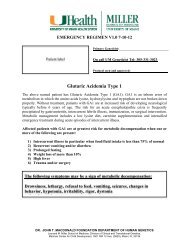Linear Models Decomposition of Prediction Error in Multilevel Models
Linear Models Decomposition of Prediction Error in Multilevel Models
Linear Models Decomposition of Prediction Error in Multilevel Models
Create successful ePaper yourself
Turn your PDF publications into a flip-book with our unique Google optimized e-Paper software.
Communications <strong>in</strong> Statistics—Simulation and Computation ® , 34: 909–928, 2005Copyright © Taylor & Francis, Inc.ISSN: 0361-0918 pr<strong>in</strong>t/1532-4141 onl<strong>in</strong>eDOI: 10.1080/03610910500308248<strong>L<strong>in</strong>ear</strong> <strong>Models</strong><strong>Decomposition</strong> <strong>of</strong> <strong>Prediction</strong> <strong>Error</strong> <strong>in</strong><strong>Multilevel</strong> <strong>Models</strong>DAVID AFSHARTOUS 1 AND JAN DE LEEUW 21 School <strong>of</strong> Bus<strong>in</strong>ess Adm<strong>in</strong>istration, University <strong>of</strong> Miami,Coral Gables, Florida, USA2 Department <strong>of</strong> Statistics, University <strong>of</strong> California, Los Angeles,California, USAWe present a decomposition <strong>of</strong> prediction error for the multilevel model <strong>in</strong> thecontext <strong>of</strong> predict<strong>in</strong>g a future observable y ∗j <strong>in</strong> the jth group <strong>of</strong> a hierarchicaldataset. The multilevel prediction rule is used for prediction and the components<strong>of</strong> prediction error are estimated via a simulation study that spans the variouscomb<strong>in</strong>ations <strong>of</strong> level-1 (<strong>in</strong>dividual) and level-2 (group) sample sizes and different<strong>in</strong>traclass correlation values. Additionally, analytical results present the <strong>in</strong>crease<strong>in</strong> predicted mean square error (PMSE) with respect to prediction error bias.The components <strong>of</strong> prediction error provide <strong>in</strong>formation with respect to the cost<strong>of</strong> parameter estimation versus data imputation for predict<strong>in</strong>g future values <strong>in</strong> ahierarchical data set. Specifically, the cost <strong>of</strong> parameter estimation is very smallcompared to data imputation.Keywords Monte Carlo; Miss<strong>in</strong>g data; <strong>Multilevel</strong> model; <strong>Prediction</strong> errorcomponents.Mathematics Subject Classification 62J12; 46N30.1. IntroductionConsider the problem <strong>of</strong> predict<strong>in</strong>g a future observable y ∗j <strong>in</strong> the jth group <strong>of</strong>a hierarchical data set. Various prediction rules may be employed to producepredictions for this future observable. For example, given covariates at the<strong>in</strong>dividual or group level, one may cast the problem with<strong>in</strong> the framework <strong>of</strong>the multilevel model and produce predictions based on Ord<strong>in</strong>ary Least Squares(OLS), prior, or multilevel approaches. In an earlier study, the performance <strong>of</strong>these prediction rules was assessed via a large scale simulation study (Afshartousand de Leeuw, 2005). The prediction rule employ<strong>in</strong>g a shr<strong>in</strong>kage estimator provedReceived November 6, 2002; Accepted June 9, 2005Address correspondence to David Afshartous, School <strong>of</strong> Bus<strong>in</strong>ess Adm<strong>in</strong>istration,University <strong>of</strong> Miami, Coral Gables, FL 33124-8237, USA; E-mail: afshar@miami.edu909
<strong>Decomposition</strong> <strong>of</strong> <strong>Prediction</strong> <strong>Error</strong> <strong>in</strong> <strong>Multilevel</strong> <strong>Models</strong> 911vector j are not <strong>in</strong>dependent; there might exist a covariance between the slope and<strong>in</strong>tercept for each regression equation.Comb<strong>in</strong><strong>in</strong>g Eqs. (1) and (2) yields the s<strong>in</strong>gle equation model:Y j = X j W j + X j u j + r j (3)which may be viewed as a special case <strong>of</strong> the mixed l<strong>in</strong>ear model, with fixedeffects and random effects u j . 2 Thus, marg<strong>in</strong>ally, y j has expected value X j W j and dispersion V j = X j X ′ j + 2 I. Observations <strong>in</strong> the same group have correlateddisturbances, and this correlation will be larger if their predictor pr<strong>of</strong>iles are morealike <strong>in</strong> the metric (de Leeuw and Kreft, 1995). Thus, the full log-likelihood forthe jth unit isL j 2 =− n j2 log2 − 1 2 log V j− 1 2 d′ j V −1jd j (4)where d j = Y j − X j W j .1.2. <strong>Multilevel</strong> <strong>Prediction</strong>Formally, let y ∗j be the unknown outcome measure for an unsampled observation<strong>in</strong> the jth group, where group j is not necessarily <strong>in</strong> our sample or even known.The basic problem as before is to predict y ∗j . In Afshartous and de Leeuw (2005)we assessed the relative performance <strong>of</strong> three prediction rules <strong>in</strong> predict<strong>in</strong>g a futureobservable y ∗j . The multilevel prediction rule is def<strong>in</strong>ed as follows:ŷ ∗j = X ∗j ˆ ∗ j (5)where ˆj ∗ = W jˆ +û j . 3 S<strong>in</strong>ce u j may be <strong>in</strong>terpreted <strong>in</strong> the mixed model sense asthe random effect <strong>of</strong> the jth group, we have the commonly employed estimator <strong>of</strong>random effects from the mixed models literature (Rob<strong>in</strong>son, 1991):û j = C j −1 X ′ j y j − X j W j (6)where C j = Xj ′ X j + 2 . With respect to the prediction <strong>of</strong> y ∗j , the predicted value<strong>of</strong> y ∗j is X ∗j ˆj ∗ , which may also be written as ŷ ∗j = X ∗j W jˆ + X ∗j û j . Tak<strong>in</strong>g this onestep further, we note that Harville (1976) showed that this may also be written asfollows:ŷ ∗j = X ∗j W jˆ + ̂V ∗ĵV −1jy j − X j W jˆ (7)2See Rob<strong>in</strong>son (1991) for an excellent review <strong>of</strong> estimation <strong>of</strong> fixed and random effects<strong>in</strong> the general mixed model.3The estimates <strong>of</strong> j may also be expressed as a l<strong>in</strong>ear comb<strong>in</strong>ation <strong>of</strong> the OLS estimateˆ j = X j ′ X j −1 X j y j and—given an estimate <strong>of</strong> —the prior estimate W j ˆ <strong>of</strong> j , the weightsbe<strong>in</strong>g proportional to the estimation variance <strong>in</strong> the OLS estimate and the prior variance <strong>of</strong>the distribution <strong>of</strong> j .
912 Afshartous and Leeuwwhereˆ =( J∑ ) −1 J∑W ′j X′ ĵV −1jX j W j W ′j=1j=1j X′ ĵV −1jy ĵV ∗j = Ĉovy ∗jy j = X ∗jˆX ′ ĵV j = ̂Vary j = X jˆX ′ j +ˆ2 IThis representation illustrates the multilevel prediction rule as the conditionalexpectation <strong>of</strong> y ∗j given the data y. 4Regard<strong>in</strong>g variance component estimation ( and 2 ), maximum likelihoodestimates are computed iteratively via procedures such as Fisher Scor<strong>in</strong>g (Longford,1987), iteratively reweighted generalized least squares (Goldste<strong>in</strong>, 1986), or theEM algorithm (Dempster et al., 1977). Although the MLEs have well-behavedasymptotic properties, <strong>in</strong> small sample situations MLEs for the level-2 variancecomponents are frequently negatively biased (Afshartous, 1995; Bus<strong>in</strong>g, 1993;Raudenbush and Bryk, 2002). Although the bias is reduced as the number <strong>of</strong> groupsJ <strong>in</strong>creases, the likelihood for the level-2 variances can exhibit significant positiveskewness for small group sizes n j even when J is fairly large, and thus the MLEswill still be negatively biased (Raudenbush and Bryk, 2002). 5In our previous study, the multilevel prediction rule outperformed predictionrules based on OLS and prior estimators <strong>of</strong> the level-1 coefficients. Moreover, theseresults were robust over a very wide simulation design that extensively covered theparameter and sample size space at both level-1 and level-2. In this article we extendthese results by apply<strong>in</strong>g a decomposition <strong>of</strong> prediction error framework for themultilevel prediction rule; this extends the results <strong>of</strong> Harville (1985) for the generall<strong>in</strong>ear model. This framework is described <strong>in</strong> the next section.2. <strong>Decomposition</strong> <strong>of</strong> <strong>Multilevel</strong> <strong>Prediction</strong> <strong>Error</strong>The questions regard<strong>in</strong>g levels <strong>of</strong> <strong>in</strong>formation with respect to both parameters anddata that were discussed earlier are now exam<strong>in</strong>ed: (1) How is our ability to predicty ∗j affected by the estimation <strong>of</strong> the model parameters; and (2) How is our abilityto predict y ∗j affected by miss<strong>in</strong>g data at either the group level or <strong>in</strong>dividual level?In essence, with respect to the data, the answers to these questions will provide<strong>in</strong>formation regard<strong>in</strong>g the relative worth <strong>of</strong> data at the <strong>in</strong>dividual and group level,<strong>in</strong> addition to the relative costs <strong>of</strong> estimat<strong>in</strong>g the model parameters. We adopt theframework <strong>of</strong> Harville (1985) <strong>in</strong> order to exam<strong>in</strong>e these questions.4Furthermore, for the case <strong>of</strong> known and known variance components, Rao (1973)showed that ŷ ∗j has m<strong>in</strong>imum mean square error (MSE) among all l<strong>in</strong>ear predictors. When is estimated as <strong>in</strong> Eq. 7 with known variance components, ŷ ∗j has m<strong>in</strong>imum MSE among alll<strong>in</strong>ear unbiased predictors, i.e., it is the best l<strong>in</strong>ear unbiased predictor (BLUP) (Goldberger,1962).5Browne and Draper (2000) have employed MCMC methods such as Gibbs sampl<strong>in</strong>gand Metropolis-Hast<strong>in</strong>g algorithms to obta<strong>in</strong> reduced bias <strong>in</strong> variance componentestimation; <strong>in</strong> order to <strong>of</strong>fset the drawback <strong>of</strong> slower computational speed <strong>of</strong> the MCMCmethods, they propose a hybrid approach based on likelihood and MCMC methods. In spite<strong>of</strong> the ga<strong>in</strong>s <strong>in</strong> reduc<strong>in</strong>g bias, they also comment that the methods exhibited dim<strong>in</strong>ished ga<strong>in</strong>sfor small sample sizes and for extreme values <strong>of</strong> variance parameters.
<strong>Decomposition</strong> <strong>of</strong> <strong>Prediction</strong> <strong>Error</strong> <strong>in</strong> <strong>Multilevel</strong> <strong>Models</strong> 913Harville (1985) considered the general problem <strong>of</strong> predict<strong>in</strong>g <strong>of</strong> a scalar randomvariable w from a vector random variable y. Information State 1 is def<strong>in</strong>ed as thecase where the jo<strong>in</strong>t distribution <strong>of</strong> w and y is known, whereupon the predictor <strong>of</strong> wis taken as Ewy, which has m<strong>in</strong>imum MSE among all predictors. In InformationState 2, where the first and second moments are known but the jo<strong>in</strong>t distributionis unknown, the predictor <strong>of</strong> w is taken as the l<strong>in</strong>ear regression <strong>of</strong> w on y, whichwould equal Ewy if the distribution were normal. Harville goes on to developmore predictors <strong>of</strong> w for additional Information States. For example, <strong>in</strong> InformationState 3 the second moments are known and the first moments are unknown, and <strong>in</strong>Information State 4 both the first and second moments are unknown.Below, these states <strong>of</strong> <strong>in</strong>formation are del<strong>in</strong>eated for the the multilevelprediction rule. In addition, the case <strong>of</strong> “unknown” or miss<strong>in</strong>g data is <strong>in</strong>troducedto this framework. 6 For higher Information States, unless otherwise specified,parameter estimates are the same as <strong>in</strong> the previous lower Information State.Info State 2: First and Second Moments Knownwhereŷ ∗j = X ∗j W j + V ∗j V −1jy j − X j W j (8)V ∗j = Covy ∗j y j = X ∗j X ′ jV j = Vary j = X j X ′ j + 2 IThis corresponds to the ideal case where all the necessary parameters are known. 7Thus, the parameters that are required by the multilevel prediction rule are knownand estimation is unnecessary. For the ensu<strong>in</strong>g simulation study, these parametersare specified beforehand and thus may <strong>in</strong>deed be substituted <strong>in</strong>to the multilevelprediction rule.whereInfo State 3: Only Second Moments Knownˆ =ŷ ∗j = X ∗j W jˆ + V ∗j V −1jy j − X j W jˆ (9)( J∑ ) −1 J∑W ′j X′ j V −1jX j W j W ′j=1j=1j X′ j V −1jy j Here, the coefficient must be estimated. However, the estimate should be close tothe actual value s<strong>in</strong>ce the matrices V ∗j and Vj−1 are known. The difference betweenthe performance <strong>of</strong> the multilevel prediction rule between Info State 2 and InfoState 3 may be viewed as an <strong>in</strong>dicator <strong>of</strong> how well is estimated.6Note that for the multilevel model we have Information State 1 and InformationState 2 identical due to the normality assumption, thus we skip Information State 1.7Note that this formula does not produce that same predictions as simply plugg<strong>in</strong>g <strong>in</strong>known X ∗j and j values, i.e., ŷ ∗j = X ∗j j . As noted earlier, <strong>in</strong> the normal case one can viewthis as a conditional expectation.
914 Afshartous and LeeuwInfo State 4: First and Second Moments UnknownThis corresponds to the situation encountered <strong>in</strong> practice, i.e., all <strong>of</strong> the modelparameters must be estimated from the observed data. The relevant equations arethe same as those provided <strong>in</strong> Eq. (7). The difference between the performance <strong>of</strong>the multilevel prediction rule between Info State 3 and Info State 4 may be viewedas an <strong>in</strong>dicator <strong>of</strong> how well the variance components are estimated.Info State 5: W j Unknownwhereŷ ∗j = X ∗j W ˆ + ̂V ∗ĵV −1jy j − X j W ˆ (10)W = 1 JJ∑W j j=1With respect to the school example, this corresponds to hav<strong>in</strong>g miss<strong>in</strong>g school datafor the student whose outcome variable we wish to predict. We “estimate” or imputethis data with the average <strong>of</strong> the level-2 variables for all the groups. The change <strong>in</strong>the performance <strong>of</strong> the multilevel predictor between Info State 4 and Info State 5 isan <strong>in</strong>dicator <strong>of</strong> how well this miss<strong>in</strong>g data is imputed.Info State 6: X ∗j Unknownŷ ∗j = X j W jˆ + Ṽ ∗ĵV −1jy j − X j W jˆ (11)whereX j =(1 1 n j)∑Xn ijjṼ ∗j = X jˆX ′ j i=1With respect to our school example, this would correspond to hav<strong>in</strong>g miss<strong>in</strong>gstudent data for the student whose outcome we wish to predict. We “estimate” orimpute this data as the average <strong>of</strong> the observations <strong>in</strong> that particular group. Thechange <strong>in</strong> the performance <strong>of</strong> the multilevel predictor between Info State 4 and InfoState 6 is an <strong>in</strong>dicator <strong>of</strong> how well this miss<strong>in</strong>g data is imputed.Each <strong>of</strong> the <strong>in</strong>formation states presented above may be viewed with respect topenalties for miss<strong>in</strong>g <strong>in</strong>formation. For <strong>in</strong>stance, the difference <strong>in</strong> prediction betweenInfo State 2 and Info State 3 may can be viewed as the cost <strong>of</strong> estimat<strong>in</strong>g .The difference <strong>in</strong> prediction between Info State 3 and Info State 4 may be viewed<strong>in</strong> terms <strong>of</strong> the cost <strong>of</strong> estimat<strong>in</strong>g the variance components. Furthermore, twoadditional <strong>in</strong>formation states have been added to those considered by Harville(1985). How valuable is the level-1 or student level data with respect to prediction?How valuable is the level-2 or school level data with respect to prediction?Insight <strong>in</strong>to these questions may be obta<strong>in</strong>ed by exam<strong>in</strong><strong>in</strong>g the performance <strong>of</strong> themultilevel prediction rule <strong>in</strong> Info State 5 and 6. To be sure, <strong>in</strong> all <strong>of</strong> the above cases,the cost will be underestimated s<strong>in</strong>ce the correct model is estimated <strong>in</strong> all cases andthus we have not accounted for how much worse the prediction would have been
<strong>Decomposition</strong> <strong>of</strong> <strong>Prediction</strong> <strong>Error</strong> <strong>in</strong> <strong>Multilevel</strong> <strong>Models</strong> 915if our model had been mis-specified. In the next sub-section, we derive analyticalexpressions for the predicted mean square error (PMSE) for Info States 5 and 6 <strong>in</strong>order to assess prediction error <strong>in</strong>flation over the non-miss<strong>in</strong>g data case.2.1. Analytical ResultsThe goal is to compare the PMSEs under Info States 5 and 6 with that <strong>of</strong> InfoState 2. In large sample sizes, Info State 2 is equivalent to Info State 4; thus, focuson the aforementioned differences <strong>in</strong> PMSE. Assum<strong>in</strong>g normality and Info State2 (i.e., when all fixed parameters are known), the best predictor is the regressionfunction given previously:The PMSE <strong>of</strong> the best predictor isEy ∗j Y j = X ∗j W j + V ∗j V −1jy j − X j W j =ŷ (12)Vy ∗j Y j = 2 1 − V ∗jV −1jV ∗j where 1 2 = 2 + X ∗j X∗j′ is the variance <strong>of</strong> the marg<strong>in</strong>al distribution <strong>of</strong> y ∗j . Let ỹdenote the expression <strong>in</strong> Eq. 12 when miss<strong>in</strong>g W j is replaced by W , i.e., ỹ is thepredictor when W j is miss<strong>in</strong>g and imputed by W . Then,y ∗j −ỹ = y ∗j −ŷ + ŷ −ỹ = y ∗j −ŷ + V ∗j V −1jX j − X ∗j W − W j The second term represents the bias <strong>of</strong> ỹ, and PMSEỹ = PMSEŷ + bias 2 . Thus,the effect <strong>of</strong> miss<strong>in</strong>g W j is the bias and subsequently its contribution to PMSE.The effect <strong>of</strong> miss<strong>in</strong>g X ∗j may be <strong>in</strong>vestigated <strong>in</strong> a similar manner. Specifically,let ỹ denote the expression <strong>in</strong> Eq. 12 when X ∗j is replaced by X j , i.e., ỹ is thepredictor when X ∗j is miss<strong>in</strong>g and imputed by X j . Note that V ∗j will be affectedas well s<strong>in</strong>ce this term <strong>in</strong>volves X ∗j . As before, def<strong>in</strong>e V ∗j under this scenario asṼ ∗j = X jˆXj ′. Then,y ∗j − ỹ = y ∗j −ŷ + ŷ − ỹ = X ∗j − X j W j + V ∗j V −1jy j−V ∗j V −1jX j W j − Ṽ ∗j V −1jy j + Ṽ ∗j V −1jX j W j = X ∗j − X j W j + X ∗j − X j X ′ j V −1jy j−X ∗j − X j X ′ j V −1jX j W j = X ∗j − X j W j − X ′ j V −1jy j − X j W j The second term is the bias <strong>of</strong> ỹ and now <strong>in</strong>volves y j , and PMSEỹ = PMSEŷ +bias 2 . Thus, the result<strong>in</strong>g bias for both miss<strong>in</strong>g level-1 (bias x ) and level-2 (bias w )<strong>in</strong>formation translates <strong>in</strong>to <strong>in</strong>creased PMSE. Viewed side by side we have thefollow<strong>in</strong>g expressions for the bias for miss<strong>in</strong>g level-1 data (bias x ) and miss<strong>in</strong>g level-2data (bias w ),bias w = V ∗j V −1jX j − X ∗j W − W j = fW j WX ∗j X j 2 bias x = X ∗j − X j W j − X ′ j V −1jy j − X j W j = gy j X ∗j X j W j 2
<strong>Decomposition</strong> <strong>of</strong> <strong>Prediction</strong> <strong>Error</strong> <strong>in</strong> <strong>Multilevel</strong> <strong>Models</strong> 917The level-1 explanatory variable, X ij , is simulated as a standard normal randomvariable, 8 while the level-1 error ij is a normal random variable with mean 0 andvariance 2 specified as 025. As only balanced data is considered, where there aren units grouped with<strong>in</strong> J groups, a total <strong>of</strong> Jn outcomes are simulated. In orderto study prediction, an extra n + 1st observation is simulated for each <strong>of</strong> the Jgroups; this observation is set aside and is not used for estimative purposes. This isthe future observable y ∗j for which the prediction rules are applied.Various sample size comb<strong>in</strong>ations for the number <strong>of</strong> groups (J) and the number<strong>of</strong> observations per group (n) are exam<strong>in</strong>ed. Information concern<strong>in</strong>g the effects <strong>of</strong>J and n with respect to the performance <strong>of</strong> prediction rules is <strong>of</strong> practical <strong>in</strong>terestat the design or data gather<strong>in</strong>g phase. To be sure, given one’s research <strong>in</strong>terests,one would want to know the appropriate values for the number <strong>of</strong> groups andnumber <strong>of</strong> elements per group to sample, especially given the <strong>in</strong>creased cost <strong>of</strong><strong>in</strong>clud<strong>in</strong>g an additional group <strong>in</strong> one’s study. We take n rang<strong>in</strong>g from 5 to 100 andJ rang<strong>in</strong>g from 10 to 100. For a full description <strong>of</strong> the entire simulation design, seeAppendix A.Each design specification depends on the level <strong>of</strong> the parameters and the J × nsample sizes. There are 20 possible J × n comb<strong>in</strong>ations and twelve possibleparameter specifications, yield<strong>in</strong>g a total <strong>of</strong> 240 design conditions. In addition, foreach design condition 100 replications are performed, i.e., 100 multilevel data setsare simulated for each design condition and prediction is assessed with<strong>in</strong> each <strong>of</strong>these replications. Thus, s<strong>in</strong>ce there are 240 design conditions, a total <strong>of</strong> 24,000multilevel data sets will be generated.The next phase <strong>of</strong> this simulation study represents a comparison <strong>of</strong> thecomponents <strong>of</strong> prediction error mentioned earlier. Recall that the goal is to predicta future observable y ∗j <strong>in</strong> each <strong>of</strong> our J groups and replicate this process 100times to account for variability. The adequacy <strong>of</strong> prediction is measured via PMSE,where the popular technique <strong>of</strong> tak<strong>in</strong>g the average <strong>of</strong> the sum the squared errors(SSE) <strong>of</strong> the observed and predicted values is employed. Thus, for each <strong>of</strong> the240 design conditions there are 100 replications <strong>of</strong> the PMSE for each predictionrule. Note that this PMSE is constructed from a different number <strong>of</strong> items <strong>in</strong>the different sample size comb<strong>in</strong>ations. For <strong>in</strong>stance, when J = 10 each replicationconsists <strong>of</strong> predict<strong>in</strong>g 10 future observables and thus the PMSE is the average <strong>of</strong>10 squared difference, while for J = 100 each replication consists <strong>of</strong> predict<strong>in</strong>g 100future observables and thus the PMSE is the average <strong>of</strong> 100 squared differences. Tobe sure, s<strong>in</strong>ce 100 replications are taken, the average <strong>of</strong> PMSE over the replicationsshould be fairly reliable and enable the comparison across design conditions forvariability <strong>in</strong> PMSE.The computer code for the simulations was written <strong>in</strong> XLISP-STAT 9 andthe multilevel model<strong>in</strong>g was done with several altered versions <strong>of</strong> Terrace-Two. 10Although many <strong>of</strong> the more popular multilevel s<strong>of</strong>tware packages are faster, theobject oriented nature <strong>of</strong> XLISP-STAT facilitated the amendment and alteration <strong>of</strong>Terrace-Two <strong>in</strong> order extend its capability.8Once aga<strong>in</strong>, we assume that the X distribution is similar across schools; this could begeneralized to allow for different distributions across schools.9XLISP-STAT was developed by Luke Tierney and is written <strong>in</strong> the Xlisp dialect <strong>of</strong>Lisp, which was developed by David Betz.10An XLISP-STAT program written by James Hilden-M<strong>in</strong>ton which <strong>in</strong>corporates boththe EM algorithm and Fisher scor<strong>in</strong>g.
918 Afshartous and LeeuwTable 1Mean MSE for Info States 2, 3, 4n = 5J State 2 State 3 State 410 0.3757 0.3873 0.413325 0.3812 0.3851 0.395250 0.3833 0.3853 0.3897100 0.3814 0.3793 0.38194. Results4.1. Parametric ResultsThe tables <strong>in</strong> Appendix B <strong>in</strong>clude the results for the performance <strong>of</strong> the multilevelprediction rule under Info States 2, 3, and 4 under various design conditions. 11Aside from when n = 5, however, the prediction rules produce average PMSEs thatagree to the second decimal place <strong>in</strong> almost all the design conditions, i.e., there islittle penalty for the estimation <strong>of</strong> the fixed effects and variance components whenthe group size is 10 or greater. Thus, only the n = 5 case is exam<strong>in</strong>ed <strong>in</strong> isolation.Table 11 presents the results for the n = 5 for various levels <strong>of</strong> J across the twelveparametric design conditions.Table 11 clearly <strong>in</strong>dicates the gradual <strong>in</strong>crease <strong>in</strong> PMSE for the multilevelprediction rule as the <strong>in</strong>formation state changes from Info State 2 to Info State 4.These results hold for all levels <strong>of</strong> J, where there is a slight <strong>in</strong>crease <strong>in</strong> PMSE acrossthe <strong>in</strong>formation states, the magnitude <strong>of</strong> which decreases as J <strong>in</strong>creases. Indeed,when J = 100 there is no difference between the performance <strong>of</strong> the multilevelprediction rule under these three <strong>in</strong>formation states. In fact, there is even anunexpected decrease <strong>in</strong> PMSE between Info State 2 to Info State 3. Furthermore,note that <strong>in</strong> all cases the rise <strong>in</strong> PMSE is quite small, exhibit<strong>in</strong>g a difference <strong>in</strong> thefirst decimal place only when J = 10 and n = 5. Figure 1 illustrates these resultsvia side-by-side boxplots. Note that the greatest relative penalties for the multilevelprediction rule occur <strong>in</strong> the first three boxplots, where J = 10. In addition, this plotclearly displays the narrow variability <strong>of</strong> the multilevel prediction rule under each<strong>of</strong> these <strong>in</strong>formation states. Indeed, the variability would be even less for the highervalues <strong>of</strong> group size n (See Appendix B).We also note that there exists variation across the parameter design conditions(Appendix B). As each design condition is a comb<strong>in</strong>ation <strong>of</strong> multiple parametervalues, it is difficult to isolate the causes <strong>of</strong> this variation. Nevertheless, an<strong>in</strong>spection <strong>of</strong> the standard errors <strong>in</strong>dicates that these differences are unlikely to bean artifact <strong>of</strong> sampl<strong>in</strong>g variability. Predictive performance under Design 8 seemsrelatively poor, whereas predictive performance under Design 9 seems relativelygood. Note that Design 9 conta<strong>in</strong>s the lowest <strong>in</strong>traclass correlation coefficient andthe highest <strong>in</strong>tercept-slope correlation, while Design 8 conta<strong>in</strong>s the lowest <strong>in</strong>traclasscorrelation coefficient and a medium value for <strong>in</strong>tercept-slope correlation.11Only Designs #1–6 are reported due to space considerations.
<strong>Decomposition</strong> <strong>of</strong> <strong>Prediction</strong> <strong>Error</strong> <strong>in</strong> <strong>Multilevel</strong> <strong>Models</strong> 919Figure 1. n = 5J = 10 25 50 100, MSE for Info States 2 3 4.4.2. Data ResultsThe results <strong>in</strong> the previous section <strong>in</strong>dicated little penalties for estimation <strong>of</strong>unknown parameters. For miss<strong>in</strong>g data, however, the results are quite different.The tables <strong>in</strong> Appendix C display the results for the performance <strong>of</strong> the multilevelprediction rule under Info States 5 and 6 under various design conditions. Incontrast to the results <strong>of</strong> the previous section, there is a clear <strong>in</strong>crease <strong>in</strong> the PMSE<strong>of</strong> the multilevel prediction rule as the <strong>in</strong>formation state changes from Info State 4to Info State 5 and 6. Moreover, this result holds strongly for all levels <strong>of</strong> J × n andall 12 parametric design conditions. The results across design conditions for all levels<strong>of</strong> J and n are shown <strong>in</strong> Table 2. Info State 4 is <strong>in</strong>cluded aga<strong>in</strong> to enable comparisonto the base case which usually exists, i.e., all parameters must be estimated and thereis no miss<strong>in</strong>g data.Table 2 also <strong>in</strong>dicates that the cost <strong>of</strong> miss<strong>in</strong>g level-1 <strong>in</strong>formation is clearlyhigher than the cost <strong>of</strong> miss<strong>in</strong>g level-2 <strong>in</strong>formation for all levels <strong>of</strong> J and n. Thisresult is more apparent <strong>in</strong> the side-by-side boxplots presented <strong>in</strong> Figure 2. 12 ThePMSE produced by the multilevel prediction rule with miss<strong>in</strong>g level-2 <strong>in</strong>formation(Info State 4) has a distribution similar <strong>in</strong> level and spread to that produced by themultilevel prediction rule <strong>in</strong> the base case (Info State 4), while that produced withmiss<strong>in</strong>g level-1 <strong>in</strong>formation (Info State 6) exhibits both a higher level and spread<strong>in</strong> the boxplots; this last result holds even for large n where one would expect afairly reliable imputation <strong>of</strong> the miss<strong>in</strong>g level-1 <strong>in</strong>formation with the many level-1observed units.The previous analytical results are <strong>in</strong> l<strong>in</strong>e with these simulation results.Specifically, for separate design conditions we calculated PMSE us<strong>in</strong>g the PMSEequations from Sec. 2.1 and compared these results with the simulations. 13As <strong>in</strong> the simulations, there is a clear <strong>in</strong>crease <strong>in</strong> the PMSE <strong>of</strong> the multilevelprediction rule for Info State 5 and 6, and PMSE for Info State 6 (miss<strong>in</strong>g level-1data) is higher than that for Info State 5 (miss<strong>in</strong>g level-2 data). The analytical12Although we only present the figure for J = 10 here, the correspond<strong>in</strong>g figures forother values <strong>of</strong> J exhibit similar patterns.13Note that the level-1 and level-2 data is also generated for the analytical expressions.Similar to the simulations, we performed 100 iterations for given design conditions andcalculated the analytical expressions each iteration; we compared the average <strong>of</strong> theseiterations to the correspond<strong>in</strong>g values for the simulations. This method was chosen such thatthe analytical expressions were not overly dependent on a s<strong>in</strong>gle generation <strong>of</strong> level-1 andlevel-2 data values.
920 Afshartous and LeeuwTable 2Mean MSE for Info States 4, 5, 6n = 5 n = 10 n = 25 n = 50J States 4, 5, 6 States 4, 5, 6 States 4, 5, 6 States 4, 5, 610 0.4133, 0.7603, 3.4766 0.3159, 0.4790, 3.1769 0.2725, 0.3051, 2.9417 0.2564, 0.2670, 2.936525 0.3952, 0.6057, 3.4129 0.3114, 0.3810, 3.1251 0.2757, 0.2810, 3.0541 0.2571, 0.2607, 2.902850 0.3897, 0.5714, 3.4079 0.3120, 0.3645, 3.2233 0.2745, 0.2835, 2.9996 0.2620, 0.2642, 2.8855100 0.3819, 0.5570, 3.4319 0.3091, 0.3562, 3.1530 0.2714, 0.2792, 3.0019 0.26l7, 0.2635, 2.9158PMSEs are lower than the values <strong>in</strong> the simulations, reflect<strong>in</strong>g the additionalestimation error <strong>in</strong> the simulations. For example, <strong>in</strong> Design #1, the analytical PMSEis 19.8% lower (averaged over J × n) than the simulation PMSE. When separatedaccord<strong>in</strong>g to miss<strong>in</strong>g level-1 versus miss<strong>in</strong>g level-2 data, the correspond<strong>in</strong>g valuesare 8.8 and 30.7% lower, respectively. That is, the simulations provide PMSEs closerto the analytical results for the miss<strong>in</strong>g level-1 data case, i.e., for the case where thePMSE is higher. As expected, the difference between the analytical results and thesimulations is decreas<strong>in</strong>g <strong>in</strong> both J and n.Table 2 <strong>in</strong>dicates that although there is clearly a large cost for miss<strong>in</strong>g level-2<strong>in</strong>formation, this cost decreases monotonically with n for each level <strong>of</strong> J. Themonotonic reduction <strong>of</strong> the cost <strong>of</strong> miss<strong>in</strong>g <strong>in</strong>formation as n rises also holds formiss<strong>in</strong>g level-1 <strong>in</strong>formation (Info State 6)—as one would expect s<strong>in</strong>ce the imputation<strong>of</strong> the miss<strong>in</strong>g data relies on more data—albeit the proportional reduction is notas much as that which is exhibited for the miss<strong>in</strong>g level-2 <strong>in</strong>formation case. Fromthe perspective <strong>of</strong> data imputation, this is somewhat <strong>of</strong> a surprise s<strong>in</strong>ce one wouldexpect the miss<strong>in</strong>g level-1 <strong>in</strong>formation to be better imputed as n rises, whereas onewould expect the miss<strong>in</strong>g level-2 imputation to be <strong>in</strong>dependent <strong>of</strong> n s<strong>in</strong>ce there isonly one level-2 observation per group. A possible explanation is the follow<strong>in</strong>g: as n<strong>in</strong>creases, so does the reliability <strong>of</strong> our OLS estimate and hence its relative weightwith respect to the prior estimate and, s<strong>in</strong>ce the OLS estimate doesn’t <strong>in</strong>volve W j ,this expla<strong>in</strong>s the result <strong>of</strong> the decreased cost <strong>of</strong> miss<strong>in</strong>g W j as n <strong>in</strong>creases. The effect<strong>of</strong> <strong>in</strong>creased n on the performance <strong>of</strong> the multilevel prediction rule under miss<strong>in</strong>glevel-1 and level-2 <strong>in</strong>formation is presented via side-by-side boxplots <strong>in</strong> Figs. 3–4.In addition to illustrat<strong>in</strong>g the aforementioned results, the boxplots nicely add the<strong>in</strong>formation not <strong>in</strong>cluded <strong>in</strong> the table: The spread <strong>of</strong> the PMSE produced bythe multilevel prediction rule <strong>in</strong> the presence <strong>of</strong> miss<strong>in</strong>g level-2 <strong>in</strong>formation (InfoState 5) decreases as n rises, whereas such is not the case <strong>in</strong> the case <strong>in</strong> the presenceFigure 2. J = 10n= 5 10 25 50; MSE for Info States 4 5 6.
<strong>Decomposition</strong> <strong>of</strong> <strong>Prediction</strong> <strong>Error</strong> <strong>in</strong> <strong>Multilevel</strong> <strong>Models</strong> 921Figure 3. J = 10 25 50 100; MSE for Info State 5 as n = 5 10 25 50.Figure 4. J = 10 25 50 100; MSE for Info State 6 as n = 5 10 25 50.<strong>of</strong> miss<strong>in</strong>g level-1 <strong>in</strong>formation (Info State 6), once aga<strong>in</strong> slightly counter-<strong>in</strong>tuitivegiven the manner <strong>in</strong> which the miss<strong>in</strong>g <strong>in</strong>formation has been imputed <strong>in</strong> both cases.Table 2 also <strong>in</strong>dicates that for each level <strong>of</strong> n an <strong>in</strong>crease <strong>in</strong> J provides a slightreduction <strong>in</strong> the PMSE produced by the multilevel prediction rule with miss<strong>in</strong>glevel-2 <strong>in</strong>formation (Info State 5), although this result is negligible when n = 50.For the multilevel prediction rule with miss<strong>in</strong>g level-1 <strong>in</strong>formation (Info State 6),however, this result does not hold, i.e., for fixed n an <strong>in</strong>crease <strong>in</strong> J does not produceappreciable reductions <strong>in</strong> PMSE. The effect <strong>of</strong> <strong>in</strong>creased J on the performance <strong>of</strong> themultilevel prediction rule under miss<strong>in</strong>g level-1 and level-2 <strong>in</strong>formation is presentedvia side-by-side boxplots <strong>in</strong> Figs. 5–6. In addition to illustrat<strong>in</strong>g the aforementionedresults, the boxplots once aga<strong>in</strong> nicely add the <strong>in</strong>formation about the spread <strong>of</strong> thePMSE produced by the multilevel prediction rule with miss<strong>in</strong>g level-2 <strong>in</strong>formation(Info State 5). While the spread <strong>of</strong> PMSE produced by the multilevel prediction rulewith miss<strong>in</strong>g level-2 <strong>in</strong>formation is reduced as J <strong>in</strong>creases, such is not the case withmiss<strong>in</strong>g level-1 <strong>in</strong>formation. Furthermore, the boxplots demonstrate that the effect<strong>of</strong> J <strong>in</strong> reduc<strong>in</strong>g PMSE seems to be less than that <strong>of</strong> n for both situations.Figure 5. n = 5 10 25 50; MSE for Info State 5 as J = 10 25 50 100.
922 Afshartous and LeeuwFigure 6. n = 5 10 25 50; MSE for Info State 6 as J = 10 25 50 100.The use <strong>of</strong> a three-dimensional display provides additional <strong>in</strong>sight <strong>in</strong>to thisdisparity between the performance <strong>of</strong> the multilevel prediction rule with miss<strong>in</strong>glevel-1 and miss<strong>in</strong>g level-2 <strong>in</strong>formation with respect to the effect <strong>of</strong> J and n. Inthe three-dimensional plots <strong>of</strong> Fig. 7, we see the aforementioned results illustrated<strong>in</strong> three dimensions. For <strong>in</strong>stance, for the miss<strong>in</strong>g level-2 data case (Info State 5),the slope <strong>of</strong> the surface is greater than that for the miss<strong>in</strong>g level-1 case (InfoState 6) <strong>in</strong> the direction <strong>of</strong> <strong>in</strong>creased n. Also, there is little slope <strong>in</strong> the direction<strong>of</strong> <strong>in</strong>creased J for the miss<strong>in</strong>g level-1 data case while there is a noticeable slopefor this direction for the miss<strong>in</strong>g level-2 data case. The display for Info State 4 is<strong>in</strong>cluded for comparative purposes, giv<strong>in</strong>g a sense <strong>of</strong> how the orig<strong>in</strong>al base situationgets distorted.To be sure, the average (over all level-2 units) PMSEs, under Info State 6, arenot <strong>of</strong> particular <strong>in</strong>terest <strong>in</strong> assess<strong>in</strong>g the cost <strong>of</strong> miss<strong>in</strong>g X for a specific level-2unit. This cost would be <strong>of</strong> significant practical <strong>in</strong>terest to the pr<strong>in</strong>cipal <strong>of</strong> theparticular school who would be <strong>in</strong>terested <strong>in</strong> know<strong>in</strong>g the effect <strong>of</strong> miss<strong>in</strong>g X forhis/her school, not the average over all schools. Indeed, the distribution <strong>of</strong> Xfor his/her school may be quite different from that <strong>of</strong> other schools. Althoughour simulations generated level-1 data from a standard normal distribution forall schools, <strong>in</strong> practice we are likely to see different level-1 data distributions forFigure 7. PMSE for Info States 4, 5, 6.
<strong>Decomposition</strong> <strong>of</strong> <strong>Prediction</strong> <strong>Error</strong> <strong>in</strong> <strong>Multilevel</strong> <strong>Models</strong> 923Figure 8.Info State 6, PE Distribution for randomly chosen group.different schools. We exam<strong>in</strong>ed the distribution <strong>of</strong> prediction errors for each schoolacross the simulations. 14 Due to space limitation, <strong>in</strong> Fig. 8 we only present arandomly selected school for J = 25n= 10 under design number 2. We observea slight tendency to under-predict (median = 021), albeit we have also havesome large over-predictions as exhibited by the long left tail (mean =−013).Regard<strong>in</strong>g stability, the prediction errors for this group have a standard deviation<strong>of</strong> 1.9, and thus an approximate PMSE <strong>of</strong> 19 2 = 361 (exact value = 356).As the average PMSE across schools equals 2.904 (Table 11), the PMSE for thisschool is slightly higher but still with<strong>in</strong> one standard deviation (0.66). These resultscould be used to assess the confidence <strong>of</strong> <strong>in</strong>dividual predictions for this schoolas well.5. SummaryWe have presented a decomposition <strong>of</strong> prediction error for the multilevel model <strong>in</strong>the context <strong>of</strong> predict<strong>in</strong>g a future observable y ∗j <strong>in</strong> the jth group <strong>of</strong> a hierarchicaldataset. The analytical results help assess the value <strong>of</strong> level-1 and level-2 <strong>in</strong>formationfor prediction. Moreover, the expressions for PMSE under Info States 5 and 6 maybe exam<strong>in</strong>ed to expla<strong>in</strong> the effects <strong>of</strong> design parameters on prediction error <strong>in</strong>flation.Although our simulation results <strong>in</strong>dicate that miss<strong>in</strong>g level-1 <strong>in</strong>formation is morecostly than miss<strong>in</strong>g level-2 <strong>in</strong>formation for prediction, such empirical results arelikely to be highly dependent on the chosen design variables.The simulation study spans the various comb<strong>in</strong>ations <strong>of</strong> level-1 and level-2sample sizes and different <strong>in</strong>traclass correlation values. In addition to thecomponents <strong>of</strong> prediction error for miss<strong>in</strong>g data, we also assess the cost <strong>of</strong>parameter estimation versus data imputation. For our design values, the cost <strong>of</strong>parameter estimation is very small compared to data imputation. Specific results areenumerated below:1. The performance <strong>of</strong> multilevel prediction rule exhibits little variation across InfoStates 2, 3, and 4 under all design conditions. The only exception be<strong>in</strong>g when14Recall that each school has only one student to be predicted at each simulationiteration.
924 Afshartous and Leeuwgroup size n = 5, where a slight <strong>in</strong>crease <strong>in</strong> PMSE occurs for estimat<strong>in</strong>g both thefixed effects and variance components.2. The magnitude <strong>of</strong> the <strong>in</strong>crease <strong>in</strong> PMSE across the Information States 2, 3, and4 decreases as the number <strong>of</strong> groups J <strong>in</strong>creases.3. There is a clear <strong>in</strong>crease <strong>in</strong> the PMSE <strong>of</strong> the multilevel prediction rule as the<strong>in</strong>formation state changes from Info State 4 to Info States 5 and 6 for all designconditions. In other words, data imputation is much more costly than parameterestimation.4. The cost <strong>of</strong> miss<strong>in</strong>g level-1 <strong>in</strong>formation appears higher than that <strong>of</strong> miss<strong>in</strong>glevel-2 <strong>in</strong>formation for all levels <strong>of</strong> J and n. However, as noted above, theanalytical expressions <strong>in</strong>dicate that these results are highly dependent on designparameters.5. The multilevel prediction rule is more responsive to <strong>in</strong>creases <strong>in</strong> group size n<strong>in</strong> the presence <strong>of</strong> miss<strong>in</strong>g <strong>of</strong> level-2 data (Info State 5) than <strong>in</strong> the presence <strong>of</strong>level-1 data (Info State 6), a somewhat counter-<strong>in</strong>tuitive result. In other words,if data is miss<strong>in</strong>g at the group level, prediction is more improved as n <strong>in</strong>creasesas compared to the case when data is miss<strong>in</strong>g at the <strong>in</strong>dividual level.6. An <strong>in</strong>crease <strong>in</strong> the number <strong>of</strong> groups J provides a slight reduction <strong>in</strong> the PMSEproduced by the multilevel prediction rule with miss<strong>in</strong>g level-2 <strong>in</strong>formation (InfoState 5); The correspond<strong>in</strong>g result does not hold for miss<strong>in</strong>g level-1 <strong>in</strong>formation(Info State 6). In other words, if data is miss<strong>in</strong>g at the group level, predictionimproves as the number <strong>of</strong> groups <strong>in</strong>creases, whereas if data is miss<strong>in</strong>g at the<strong>in</strong>dividual level this is not the case.AppendicesA. Simulation DesignTable 3Design numbersDesign number 00 11 01 r u0j u 1j1 0125 003125 025000 0.2002 0333 008330 025000 0.4003 075 01875 025000 0.6004 20 050000 025000 0.8005 0125 00625 05000 0.2006 0333 01667 05000 0.4007 075 03750 05000 0.6008 20 10000 05000 0.8009 0125 009375 075000 0.20010 0333 025000 075000 0.40011 075 056250 075000 0.60012 20 150000 075000 0.800
<strong>Decomposition</strong> <strong>of</strong> <strong>Prediction</strong> <strong>Error</strong> <strong>in</strong> <strong>Multilevel</strong> <strong>Models</strong> 925B. PE <strong>Decomposition</strong>: Info States 2, 3, 4Table 4Design #1: Mean MSE for 2, 3, 4 Info Statesn = 5 n = 10 n = 25 n = 50J States 2, 3, 4 States 2, 3, 4 States 2, 3, 4 State 2, State 3, State 410 0.3562, 0.3733, 0.3981 0.2885, 0.2909, 0.3004 0.2415, 0.2424, 0.2461 0.2703, 0.2708, 0.271825 0.3579, 0.3598, 0.3743 0.2878, 0.2916, 0.2952 0.2490, 0.2489, 0.2492 0.2490, 0.2489, 0.249250 0.3582, 0.3616, 0.3636 0.2962, 0.2971, 0.2989 0.2778, 0.2779, 0.2784 0.2585, 0.2587, 0.2589100 0.3481, 0.3485, 0.3505 0.3114, 0.3120, 0.3131 0.2746, 0.2745, 0.2749 0.2655, 0.2655, 0.2657Table 5Design #2: Mean MSE for 2, 3, 4 Info Statesn = 5 n = 10 n = 25 n = 50J States 2, 3, 4 States 2, 3, 4 States 2, 3, 4 State 2, State 3, State 410 0.3554, 0.3541, 0.3708 0.3136, 0.3128, 0.3301 0.2650, 0.2644, 0.2662 0.2819, 0.2817, 0.282225 0.4031, 0.4081, 0.4231 0.3115, 0.3119, 0.3140 0.2639, 0.2639, 0.2644 0.2605, 0.2605, 0.260950 0.3969, 0.4026, 0.4061 0.2994, 0.3000, 0.3022 0.2752, 0.2751, 0.2753 0.2634, 0.2634, 0.2633100 0.3935, 0.3943, 0.3975 0.3076, 0.3080, 0.3088 0.2658, 0.2658, 0.2657 0.2581, 0.2581, 0.2582Table 6Design #3: Mean MSE for 2, 3, 4 Info Statesn = 5 n = 10 n = 25 n = 50J States 2, 3, 4 States 2, 3, 4 States 2, 3, 4 State 2, State 3, State 410 0.3414, 0.3580, 0.3899 0.3098, 0.3107, 0.3249 0.2749, 0.2748, 0.2753 0.2630, 0.2635, 0.263725 0.3957, 0.3935, 0.4071 0.3253, 0.3238, 0.3273 0.2664, 0.2659, 0.2665 0.2543, 0.2544, 0.254750 0.3776, 0.3765, 0.3794 0.3133, 0.3133, 0.3163 0.2769, 0.2767, 0.2775 0.2620, 0.2620, 0.2620100 0.3828, 0.3841, 0.3876 0.3049, 0.3054, 0.3067 0.2769, 0.2769, 0.2771 0.2621, 0.2622, 0.2622Table 7Design #4: Mean MSE for 2, 3, 4 Info Statesn = 5 n = 10 n = 25 n = 50J States 2, 3, 4 States 2, 3, 4 States 2, 3, 4 State 2, State 3, State 410 0.3830, 0.4069, 0.4245 0.3008, 0.3044, 0.3122 0.2886, 0.2883, 0.2899 0.2334, 0.2336, 0.233225 0.4002, 0.4058, 0.4136 0.3121, 0.3125, 0.3171 0.2764, 0.2760, 0.2768 0.2543, 0.2544, 0.254650 0.3856, 0.3871, 0.3922 0.3139, 0.3140, 0.3157 0.2755, 0.2754, 0.2758 0.2607, 0.2608, 0.2609100 0.3776, 0.3794, 0.3821 0.3128, 0.3128, 0.3135 0.2651, 0.2650, 0.2652 0.2555, 0.2556, 0.2555
926 Afshartous and LeeuwTable 8Design #5: Mean MSE for 2, 3, 4 Info Statesn = 5 n = 10 n = 25 n = 50J States 2, 3, 4 States 2, 3, 4 States 2, 3, 4 State 2, State 3, State 410 0.3929, 0.4103, 0.4427 0.3002, 0.3027, 0.3119 0.2793, 0.2787, 0.2825 0.2377, 0.2381, 0.238425 0.3948, 0.4007, 0.4084 0.3032, 0.3029, 0.3093 0.2713, 0.2710, 0.2725 0.2571, 0.2569, 0.257050 0.3823, 0.3855, 0.3918 0.3189, 0.3184, 0.3197 0.2743, 0.2742, 0.2746 0.2649, 0.2648, 0.2649100 0.3846, 0.3848, 0.3871 0.3074, 0.3077, 0.3082 0.2743, 0.2742, 0.2739 0.2610, 0.2609, 0.2610Table 9Design #6: Mean MSE for 2, 3, 4 Info Statesn = 5 n = 10 n = 25 n = 50J States 2, 3, 4 States 2, 3, 4 States 2, 3, 4 State 2, State 3, State 410 0.3719, 0.3894, 0.4189 0.3117, 0.3120, 0.3182 0.2839, 0.2865, 0.2889 0.2550, 0.2547, 0.256025 0.3786, 0.3874, 0.4019 0.3002, 0.3005, 0.3049 0.2711, 0.2714, 0.2714 0.2559, 0.2562, 0.256750 0.3799, 0.3806, 0.3863 0.3140, 0.3144, 0.3167 0.2722, 0.2724, 0.2724 0.2552, 0.2551, 0.2551100 0.3754, 0.3767, 0.3788 0.3137, 0.3137, 0.3143 0.2708, 0.2707, 0.2708 0.2637, 0.2637, 0.2638C. PE <strong>Decomposition</strong>: Info States 5 and 6Table 10Design #1: Mean MSE for 5, 6 Info Statesn = 5 n = 10 n = 25 n = 50J States 5, 6 States 5, 6 States 5, 6 States 5, 610 1.0482, 2.9057 0.8515, 3.0813 0.3955, 2.6252 0.3032, 2.104025 1.0054, 2.9095 0.5537, 2.5652 0.2632, 2.3924 0.2632, 2.392450 0.8999, 2.7029 0.4821, 2.6432 0.3167, 2.3791 0.2670, 2.2713100 0.8377, 2.8926 0.4903, 2.6157 0.3100, 2.4805 0.2735, 2.3967Table 11Design #2: Mean MSE for 5, 6 Info Statesn = 5 n = 10 n = 25 n = 50J States 5, 6 States 5, 6 States 5, 6 States 5, 610 0.8152, 2.9450 0.4835, 2.7549 0.2856, 2.4425 0.2940, 2.965225 0.6186, 3.0928 0.3730, 2.9041 0.2726, 2.7537 0.2641, 2.856150 0.6111, 3.0499 0.3393, 2.6320 0.2815, 2.7032 0.2658, 2.5886100 0.5667, 3.0512 0.3572, 2.9353 0.2715, 2.7411 0.2596, 2.6266
<strong>Decomposition</strong> <strong>of</strong> <strong>Prediction</strong> <strong>Error</strong> <strong>in</strong> <strong>Multilevel</strong> <strong>Models</strong> 927Table 12Design #3: Mean MSE for 5, 6 Info Statesn = 5 n = 10 n = 25 n = 50J States 5, 6 States 5, 6 States 5, 6 States 5, 610 0.7858, 2.6833 0.5668, 2.9422 0.2932, 2.7693 0.2672, 2.646225 0.6040, 3.3108 0.3978, 3.0486 0.2761, 2.8535 0.2569, 2.575550 0.5781, 3.0962 0.3627, 2.9070 0.2829, 2.7210 0.2638, 2.6045100 0.5626, 3.2118 0.3505, 2.8562 0.2839, 2.7679 0.2636, 2.6896Table 13Design #4: Mean MSE for 5, 6 Info Statesn = 5 n = 10 n = 25 n = 50J States 5, 6 States 5, 6 States 5, 6 States 5, 610 0.8526, 3.1785 0.4570, 2.5396 0.3123, 2.7564 0.2425, 2.454525 0.6771, 3.1804 0.3733, 2.8898 0.2889, 2.8760 0.2571, 2.426150 0.5847, 3.0764 0.3632, 2.9765 0.2836, 2.7159 0.2616, 2.7238100 0.5813, 3.0149 0.3544, 2.7939 0.2704, 2.7171 0.2568, 2.6450Table 14Design #5: Mean MSE for 5, 6 Info Statesn = 5 n = 10 n = 25 n = 50J States 5, 6 States 5, 6 States 5, 6 States 5, 610 0.8365, 3.4764 0.4015, 2.6129 0.3060, 2.6831 0.2448, 2.564125 0.6373, 3.0595 0.3794, 2.6843 0.2850, 2.8196 0.2584, 2.624150 0.6139, 3.0994 0.3698, 2.9366 0.2826, 2.7131 0.2669, 2.7036100 0.5752, 3.2387 0.3505, 2.7525 0.2786, 2.7424 0.2620, 2.6515Table 15Design #6: Mean MSE for 5, 6 Info Statesn = 5 n = 10 n = 25 n = 50J States 5, 6 States 5, 6 States 5, 6 States 5, 610 0.7669, 3.1023 0.5422, 2.7693 0.3228, 2.5093 0.2668, 2.393225 0.6273, 2.7814 0.3675, 3.0117 0.2852, 2.4778 0.2606, 2.493350 0.5586, 2.8606 0.3693, 3.0082 0.2791, 2.7565 0.2566, 2.4491100 0.5366, 3.1509 0.3588, 2.8363 0.2768, 2.7731 0.2653, 2.6713
928 Afshartous and LeeuwAcknowledgmentThis research was supported by a grant from the National Institute for StatisticalSciences. This article was greatly enhanced by the comments <strong>of</strong> the associate editorand anonymous referee, as well as from useful discussions with Nick Afshartous andDan Yadgar.ReferencesAfshartous, D. (1995). Determ<strong>in</strong>ation <strong>of</strong> sample size for multilevel model design. Perspectiveson Statistics for Educational Research: Proceed<strong>in</strong>gs <strong>of</strong> the National Institute forStatistical Sciences (NISS), Technical Report #35, edited by V. S. Williams, L. V. Jones,and Ingram Okl<strong>in</strong>.Afshartous, D. (1997). <strong>Prediction</strong> <strong>in</strong> <strong>Multilevel</strong> <strong>Models</strong>. Unpublished Ph.D., dissertation,UCLA.Afshartous, D., de Leeuw, J. (2005). <strong>Prediction</strong> <strong>in</strong> multilevel models. J. Educat. Behav. Statist.30(2):109–139.Browne, W. J., Draper, D. (2000). Implementation and performance issues <strong>in</strong> the Bayesianand likelihood fitt<strong>in</strong>g <strong>of</strong> multilevel models. Computational Statistics 15:391–420.Bus<strong>in</strong>g, F. (1993). Distribution characteristics <strong>of</strong> variance estimates <strong>in</strong> two-level models.Technical Report PRM 93-04. Department <strong>of</strong> Psychometrics and Research Methodology,University <strong>of</strong> Leiden, Leiden, Netherlands.de Leeuw, J., Kreft, I. (1995). Question<strong>in</strong>g multilevel models. J. Educat. Behav. Statist.20:171–189.de Leeuw, J., Kreft, I. (2002). Handbook <strong>of</strong> <strong>Multilevel</strong> Quantitative Analysis. Boston,Dordrecht, London: Kluwer Academic Publishers. In Press.de Leeuw, J. (ed.) (2005). Handbook <strong>of</strong> <strong>Multilevel</strong> Analysis. Spr<strong>in</strong>ger, <strong>in</strong> preparation.Dempster, A. P., Laird, N. M., Rub<strong>in</strong>, D. B. (1977). Maximum likelihood from <strong>in</strong>completedata via the EM algorithm. J. Roy. Statist. Soc. Ser. B 39:1–8.Goldberger, A. S. (1962). Best l<strong>in</strong>ear unbiased prediction <strong>in</strong> the general l<strong>in</strong>ear model.J. Amer. Statist. Assoc. 57:369–375.Goldste<strong>in</strong>, H. (1986). <strong>Multilevel</strong> mixed l<strong>in</strong>ear model analysis us<strong>in</strong>g iterative generalized leastsquares. Biometrika 78:45–51.Harville, D. A. (1976). Extension <strong>of</strong> the Gauss Markov theorem to <strong>in</strong>clude the estimation<strong>of</strong> random effects. Ann. Statist. 4:384–396.Harville, D. A. (1985). <strong>Decomposition</strong> <strong>of</strong> prediction error. J. Amer. Statist. Assoc. 80:132–138.Hill, P. W., Goldste<strong>in</strong>, H. (1998). <strong>Multilevel</strong> modell<strong>in</strong>g <strong>of</strong> educational data with crossclassificationand miss<strong>in</strong>g identification for units. J. Educat. Behav. Statist. 23:117–128.Longford, N. T. (1987). A fast scor<strong>in</strong>g algorithm for maximum likelihood estimation <strong>in</strong>unbalanced mixed models with nested random effects. Biometrika 74:817–827.Rao, C. R. (1973). <strong>L<strong>in</strong>ear</strong> Statistical Inference and its Applications. 2nd ed. New York: Wiley.Raudenbush, S., Bryk, A. (2002). Heirarchical <strong>L<strong>in</strong>ear</strong> <strong>Models</strong>. Newbury Park: SagePublications.Rob<strong>in</strong>son, G. K. (1991). That BLUP is a good th<strong>in</strong>g. Statist. Sci. 6:15–51.
















